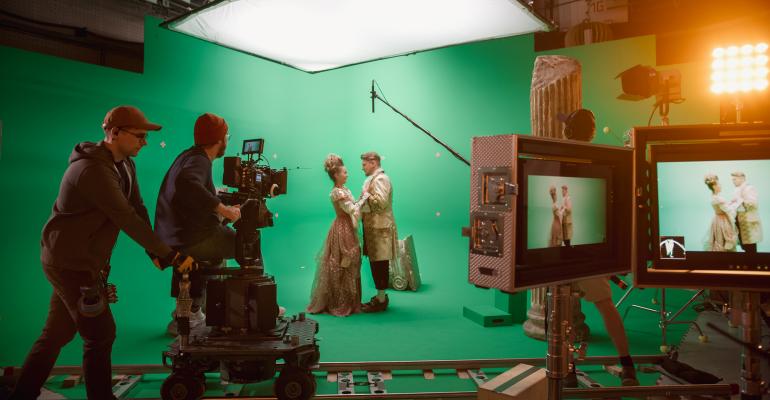Major investors are pouring more and more money into these assets.
On July 29, Blackstone and Hudson Pacific Properties announced plans to invest $170 to $190 million to develop a 240,000-sq.-ft. production studio on the edge of Los Angeles, a 20-minute drive north of Hollywood in Sun Valley. The property, dubbed Sunset Glenoaks Studios, will be the first new large-scale production studio facility built in the Los Angeles area in over 20 years.
Just three days later, news broke that Blackstone and Hudson Pacific also plan to build a studio production complex outside London. The two acquired a 91-acre property for £120 million and expect investment for the development to total over £700 million. The development is the first addition outside the U.S. under their growing joint venture, Sunset Studios.
The two properties are the latest in a wave of studio deals by big-name real estate investors that continues to grow, even as more traditional asset classes begin to recover from the disruption of 2020. As of June, more than 1.2 million sq. ft. of new sound stage space was being planned or built in greater Los Angeles, according to real estate services firm CBRE. This represents major growth in new development relative to the region’s existing 5.3 million sq. ft. of sound stages, as tracked by FilmLA.
The surge in studio investments is tied to the rapidly rising demand for streaming content on platforms like Netflix and Amazon Prime. The boom has seen the entertainment industry scrambling to find enough production space to produce new content and demand has only continued to soar as viewers spend more time at home during the COVID-19 pandemic.
“Right now anything that can be labeled a studio is in demand—even substandard converted warehouses—but the focus is on creating sound stages and studio lots that meet today’s standards for filming,” says Billy Sherman, managing director with real estate investment banking firm Eastdil Secured. “The analogy is that studios and sound stages are highly specialized manufacturing facilities for filmed content. The better the manufacturing facility, the better the end product, so every entertainment company is seeking access to what is a limited number of high quality studios.”
California-based Relativity Architects reports that around half of the properties where the firm is now designing studios were previously set to become warehouses.
The wave of new development is driven by the fact that sound stage inventory has remained relatively static while spending on original content production has doubled in the last few years, according to Sherman.
The demand for new development is also tied to very low vacancy rates for industrial space.
“Industrial space historically provided a relief valve to production spaces when traditional stages weren’t available,” says Craig Peters, executive vice president at CBRE. “With virtually no industrial space available in major markets and those landlords with vacancy looking for long-term leases, that isn’t a good match for excess production demand.”
This shortage of flexible industrial space is one of the factors pushing investor demand for warehouses that can be permanently converted to studios.
But demand for production studios was already growing before the COVID-19 pandemic. L.A. North Studios, now one of the region’s bigger players, was founded in 2018 and Netflix purchased Albuquerque Studios in New Mexico that same year. Even as most asset classes struggled through 2020, announcements of new production studio deals continued.
“This is actually an old industry, but it’s in the middle of a major disruption with the launch of the digital platforms and the continued rise in subscription services,” says Jesse Goepel, managing director with investment management firm Square Mile Capital.
In January, Square Mile worked with Hackman Capital, the region’s largest independent owner of production space, on the purchase of the Sony Pictures Animation campus for $160 million—Hackman has built a portfolio of $3.8 billion in studio and media investments in just the past three years. The Sony Pictures deal was the start of a string of new studio investments through the first half of 2021.
In April, Atlanta’s Blackhall Studios, one of Georgia’s largest production companies, was bought by private equity firm Commonwealth Group for $120 million. Blackhall owns 850,000 sq. ft. of space and nine sound stages in the state, as well as studios in Los Angeles and London.
In May, Atlas Capital Group proposed a $650 million plan to redevelop a property in downtown Los Angeles which the firm already owned into a 832,000-sq.-ft. campus with 300,000 sq. ft. of production space. Atlas Capital’s plan for 8th and Alameda Studios will convert the building where the Los Angeles Times is currently printed into 11 new sound stages, and will also create new facilities with six additional sound stages.
The same month, Bardas Investment Group and Bain Capital announced the $450 million Echelon Studios project, a redevelopment of a former Sears store in West Hollywood that will include five sound stages totaling more than 90,000 sq. ft.
Good timing
The new Blackstone-Hudson Pacific development in Los Angeles will bring the Sunset Studios portfolio for the area to 42 stages and studio properties covering 3.5 million sq. ft. This will include an expansion of Sunset Gower Studios, announced last November, that will double the size of the facilities with 480,000 additional sq. ft. and two new soundstages. After the first quarter of 2021, Hudson Pacific reported a 5.9 percent increase in year-over-year net operating income for the Sunset Gower, Bronson and Las Palmas studio facilities.
The drive for new studio development is now also backed by the California government. In mid-July, the state legislature approved a new $150-million tax credit for sound stage construction, as well as a $180-million increase to the $330-million film production credit.
One beneficiary of the new credits is the Blackstone-Hudson Pacific Sunset Glenoaks project, which includes seven new sound stages. Though the plan was originally proposed seven years ago, it will now benefit from the state’s expanded tax incentives.
According to CBRE, demand in the sector falls into three categories: investors developing purpose-built studios, studio operators looking to convert existing properties and private or institutional investors seeking to acquire existing studios.
One new redevelopment project is a plan announced in June by New York-based East End Capital to build out a cold storage warehouse in Los Angeles’ Boyle Heights and convert it into a 237,000-sq.-ft. production studio facility with four sound stages.
Studio soundstages can often bring in revenue for investors much faster than other types of developments; in prime locations in Los Angeles, rents for regular office space might average around $2.25 per sq. ft., while studio space will lease for as much as $5.0 per sq. ft.
How much growth is possible?
But despite the attractive revenue prospects and the bullish market, there is still an inherent limit to production studios as an investment opportunity. The most successful properties must be located in major markets with an entertainment industry, including specialized skilled labor, and ideally tax incentives as well.
As more capital has poured into the sector, interest rates for studios have dropped, with cap rates coming into line with those for best-in-class investments from other asset classes, reportedly in the mid-3 percent range.
“Institutional capital has always loved industrial real estate and today that demand is pushing cap rates to record lows and resulting in record high prices,” says Craig Peters, of CBRE. “Many of those same institutional investors are also looking at the studio space today and including it in their portfolio.”
According to Goepel, the asset class may face a ceiling because of the broadening demand among investors.
“There is a limited stock of existing assets, but we are seeing a lot of development activity, so I think the future development will really be the determinant of how big this sector gets,” Goepel notes. “Not all projects that are announced in the press are actually capitalized or entitled, so not everything we hear about will be built. But we will certainly see this sector continue to grow and we believe there is still a lot of runway with the content providers as it’s all about production these days and demand for high quality production space is as robust as it has ever been.”
As more investors become comfortable with studio assets, some in the industry expect the sector’s fundamentals will likely start to look more like traditional real estate classes, for example industrial or multifamily.
“With more capital chasing a limited number of opportunities that is driving down cost of capital and return targets. Also, with production studios being an operating business in addition to real estate, most players are seeking to build scale,” says Sherman. “More scale creates operating efficiencies and pricing leverage with customers.”
In addition, some of the major real estate players investing in studios—including Hackman, Blackstone and Hudson Pacific—may focus on longer holding periods. This is driven in part by demand within the entertainment production industry for increasingly long leases, sometimes for years at a time.
So far, production studios are on track to become a regular part of commercial real estate portfolios. According to CBRE, investors can expect an announcement of another new major studio development in the next 60 to 90 days that will be larger than the Sunset Glenoaks Studios project, as well as significant news around studio sales.
Source: Read Original Article






